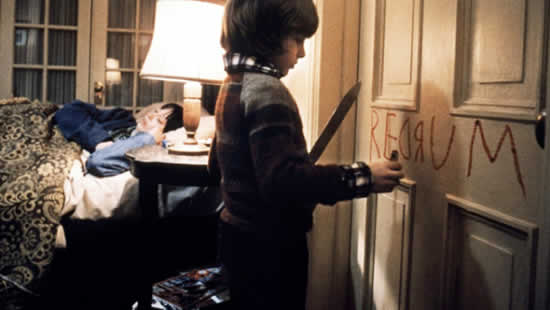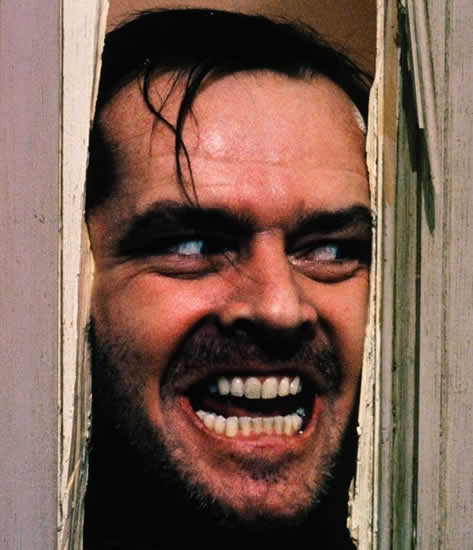 In 1980 Stanley Kubrick released his classic horror film, THE SHINING. Over 30 years later, viewers are still struggling to understand its hidden meanings. Loved and hated by equal numbers, the film is considered a genre standard by many loyalists, while other viewers dismiss it as the lazy result of a legendary director working far below his talent level. In between these two poles, however, live the theories of ardent fans who are convinced they have decoded THE SHINING’s secret messages regarding genocide, government conspiracy, and the nightmare that we call history. Ascher’s ROOM 237 fuses fact and fiction through interviews with the fans and scholars who espouse these theories. Ideas of five devotees of the film with wildly different ideas about its true meaning are braided together in a kaleidoscopic deconstruction of the horror classic.
In 1980 Stanley Kubrick released his classic horror film, THE SHINING. Over 30 years later, viewers are still struggling to understand its hidden meanings. Loved and hated by equal numbers, the film is considered a genre standard by many loyalists, while other viewers dismiss it as the lazy result of a legendary director working far below his talent level. In between these two poles, however, live the theories of ardent fans who are convinced they have decoded THE SHINING’s secret messages regarding genocide, government conspiracy, and the nightmare that we call history. Ascher’s ROOM 237 fuses fact and fiction through interviews with the fans and scholars who espouse these theories. Ideas of five devotees of the film with wildly different ideas about its true meaning are braided together in a kaleidoscopic deconstruction of the horror classic.
Tim Kirk, producer of Room 237 has sold screenplays and pitches to Universal, Sony Pictures, MGM, New Line and 20th Century Fox. His short film Bewitched? was featured at the 2006 Los Angeles Film Festival. Tim is proud to have written the narration for the Hall of the Crucifixion at Forest Lawn in Glendale which shows upon the hour, six days a week. He lives in Los Angeles with his wife and 3-year-old daughter.
Bijan Tehrani: I myself have been a Stanley Kubrick fan and I can tell you that “The Shining” shocked me as I felt it was not the kind of work he should have done. But after watching the film you have produced, Room 237, last night, I want to watch Shining at least a few times, because now I feel a little bit ashamed that I didn’t notice all these messages you have mentioned in your film.Please tell us how you came up with the idea of the film.
Tim Kirk: I snuck in the theater to see the film when I was about 15 at Grauman’s when it premiered. I was a big Kubrick fan, I had seen all of his stuff but this was the first one I saw in the theater and I had very high expectations. Like you, I was a little disappointed but I was also just incredibly intrigued by the film. We visited it a lot in college and I guess it never left me because I found an article online written by one of the guys we ended up interviewing. It was a … 1:44 and we both began scouring for more theories on the film. That was our road into exploring this discussion.
BT: How much time did your team spend on research?
TK: We spent about 8 months researching before we even interviewed anyone. A lot of this time was spent finding the people we would interview and a large part was also spent on discussing the style we wanted for the film. We present every theory as persuasively and objectively as we could without our own opinion.
BT: It’s one of the rare films that is so successful in doing this in an entertaining way – it is not boring but exciting to watch. How did you come up with the visual style of the film?
TK: Thank you. Rodney (Ascher) had made a short film about a year before that I was involved with very incriminally. I think I even held the tripod or a light in one shot… That was sort of the genesis of his style. Rodney was looking to do a feature version of that and I was encouraging him to, and this seemed like a great film for this, especially because it’s like looking at a film over and over.
BT: We are used to reading analysis but not to seeing it on the screen. It’s great for a movie theater audience but I think it would be great for any class on film history or film language.
TK: Thank you. If there’s a granddaddy to this style of filmmaking, there’s a great film called “L.A. Plays Itself” by Thom Andersen. He is a professor of film at CalArts and shows clips from many films that were shot in Los Angeles and discusses the character of Los Angeles in film… so I can see that it could have a place in Film Critic Studies.
BT: Have you screened this film anywhere and what was the audience reaction?
TK: I have, all over the world actually and the reactions have been very good and very varied. The Holocaust stuff played a little bit differently in Homberg than it did in Spain. The Native American stuff felt a little more pleasant when it showed it in Sundance.
BT: What are your future projects?
TK: We’re starting two documentaries. We’ve began doing interviews on both. I imagine we’ll complete both but at the moment they’re both vying for our affection right now – we’re not sure which one we are ready to give fourteen hours a day to yet… but stay tuned in! We have some good stuff coming.
BT: It seems like this film was mainly shaped in the editing room or did you have a script prior to shooting and finding the material?
TK: That’s a very astute observation. It was a long research, but after we did the interviews, we came up with a couple of points we wanted to hit. Robbie would cut stuff for me from the interviews -5 to 7 minute-pieces, and at the end of the process we’d have about a couple dozen of these pieces. We’d scrap notes on pieces of paper, glue these specs to the wall, re-arrange them a bunch of times until we found our form. So there was a lot of discovery, even in the final stages, even in the structure.

